In vivo long-term synaptic plasticity of glial cells
- PMID: 20142269
- PMCID: PMC2852994
- DOI: 10.1113/jphysiol.2009.178988
In vivo long-term synaptic plasticity of glial cells
Abstract
Evidence showing the ability of glial cells to detect, respond to and modulate synaptic transmission and plasticity has contributed to the notion of glial cells as active synaptic partners. However, synaptically induced plasticity of glia themselves remains ill defined. Here we used the amphibian neuromuscular junction (NMJ) to study plasticity of perisynaptic Schwann cells (PSCs), glial cells at this synapse, following long-term in vivo modifications of synaptic activity. We used two models that altered synaptic activity in different manners. First, chronic blockade of postsynaptic nicotinic receptors using alpha-bungarotoxin (alpha-BTx) decreased facilitation, increased synaptic depression and decreased post-tetanic potentiation (PTP). Second, chronic nerve stimulation increased facilitation and resistance to synaptic depression, while leaving PTP unaltered. Our results indicate that there is no direct relationship between transmitter release and PSC calcium responses. Indeed, despite changes in transmitter release and plasticity in stimulated NMJs, nerve-evoked PSC calcium responses were similar to control. Similarly, PSC calcium responses in alpha-BTx treated NMJs were delayed and smaller in amplitude, even though basal level of transmitter release was increased. Also, when isolating purinergic and muscarinic components of PSC calcium responses, we found an increased sensitivity to ATP and a decreased sensitivity to muscarine in chronically stimulated NMJs. Conversely, in alpha-BTx treated NMJs, PSC sensitivity remained unaffected, but ATP- and muscarine-induced calcium responses were prolonged. Thus, our results reveal complex modifications of PSC properties, with differential modulation of signalling pathways that might underlie receptor regulation or changes in Ca(2+) handling. Importantly, similar to neurons, perisynaptic glial cells undergo plastic changes induced by altered synaptic activity.
Figures

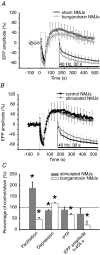
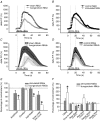

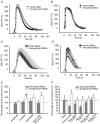
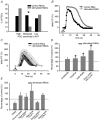
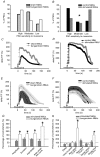
Similar articles
-
Properties of Glial Cell at the Neuromuscular Junction Are Incompatible with Synaptic Repair in the SOD1G37R ALS Mouse Model.J Neurosci. 2020 Sep 30;40(40):7759-7777. doi: 10.1523/JNEUROSCI.1748-18.2020. Epub 2020 Aug 28. J Neurosci. 2020. PMID: 32859714 Free PMC article.
-
Synapse-glia interactions are governed by synaptic and intrinsic glial properties.Neuroscience. 2010 May 19;167(3):621-32. doi: 10.1016/j.neuroscience.2010.02.036. Epub 2010 Feb 24. Neuroscience. 2010. PMID: 20188148
-
Perisynaptic Schwann cells at the neuromuscular junction: nerve- and activity-dependent contributions to synaptic efficacy, plasticity, and reinnervation.Neuroscientist. 2003 Apr;9(2):144-57. doi: 10.1177/1073858403252229. Neuroscientist. 2003. PMID: 12708618 Review.
-
Long-term in vivo modulation of synaptic efficacy at the neuromuscular junction of Rana pipiens frogs.J Physiol. 2005 Nov 15;569(Pt 1):163-78. doi: 10.1113/jphysiol.2005.094805. Epub 2005 Sep 15. J Physiol. 2005. PMID: 16166159 Free PMC article.
-
Glial modulation of synaptic transmission at the neuromuscular junction.Glia. 2004 Aug 15;47(3):284-289. doi: 10.1002/glia.20086. Glia. 2004. PMID: 15252818 Review.
Cited by
-
Properties of Glial Cell at the Neuromuscular Junction Are Incompatible with Synaptic Repair in the SOD1G37R ALS Mouse Model.J Neurosci. 2020 Sep 30;40(40):7759-7777. doi: 10.1523/JNEUROSCI.1748-18.2020. Epub 2020 Aug 28. J Neurosci. 2020. PMID: 32859714 Free PMC article.
-
Beyond New Neurons in the Adult Hippocampus: Imipramine Acts as a Pro-Astrogliogenic Factor and Rescues Cognitive Impairments Induced by Stress Exposure.Cells. 2022 Jan 24;11(3):390. doi: 10.3390/cells11030390. Cells. 2022. PMID: 35159199 Free PMC article.
-
Clinical relevance of terminal Schwann cells: An overlooked component of the neuromuscular junction.J Neurosci Res. 2018 Jul;96(7):1125-1135. doi: 10.1002/jnr.24231. Epub 2018 Mar 13. J Neurosci Res. 2018. PMID: 29536564 Free PMC article. Review.
-
Astroglial calcium signaling displays short-term plasticity and adjusts synaptic efficacy.Front Cell Neurosci. 2015 May 27;9:189. doi: 10.3389/fncel.2015.00189. eCollection 2015. Front Cell Neurosci. 2015. PMID: 26074766 Free PMC article.
-
Perisynaptic Schwann Cells at the Neuromuscular Synapse: Adaptable, Multitasking Glial Cells.Cold Spring Harb Perspect Biol. 2015 Aug 20;7(10):a020503. doi: 10.1101/cshperspect.a020503. Cold Spring Harb Perspect Biol. 2015. PMID: 26430218 Free PMC article. Review.
References
Publication types
MeSH terms
Substances
Grants and funding
LinkOut - more resources
Full Text Sources
Miscellaneous

